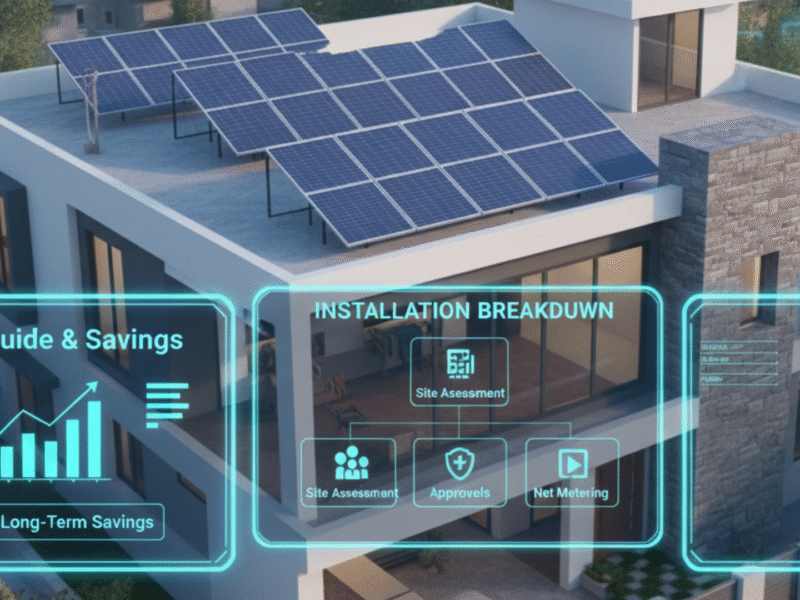
The transition to solar energy is one of the smartest financial and environmental decisions a homeowner can make. However, the first question everyone asks is: “What is the actual solar panel price for home?”
Thanks to aggressive government initiatives like the PM Surya Ghar: Muft Bijli Yojana, achieving energy independence through solar has become remarkably affordable. This comprehensive guide aims to demystify the entire process. We will break down the true cost of solar panel installation for a home, clarify what the price includes, detail the latest subsidy structures, and provide a step-by-step installation overview.
Ultimately, understanding the investment, the returns, and the simple path to achieving zero electricity bills empowers you to take the next step.
The Core Investment: Solar Panel Price for Home by System Size
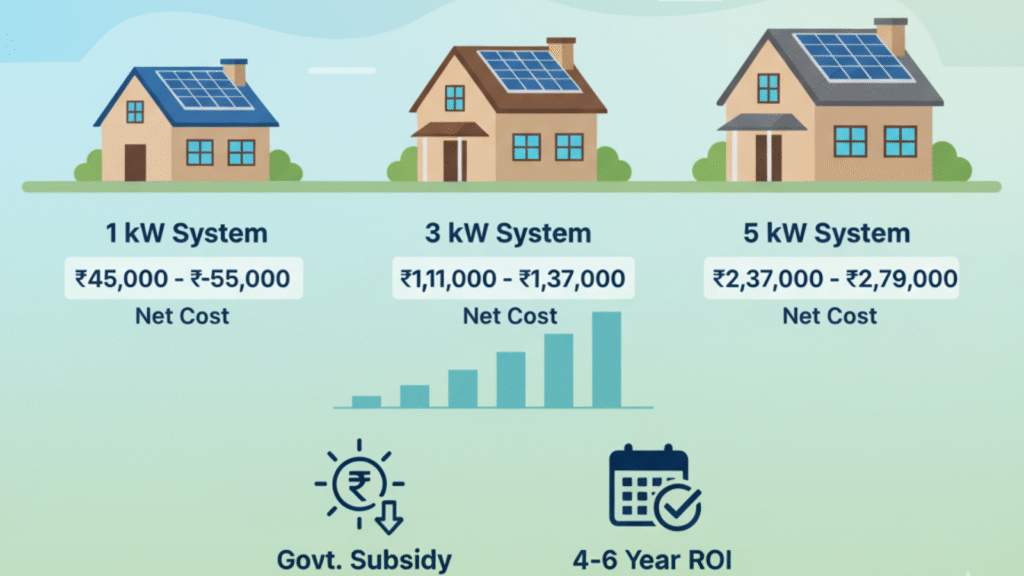
The final solar panel price for home is primarily determined by your system’s capacity in kilowatts (kW), which links directly to your average monthly electricity consumption. A larger system generates more power, resulting in a higher upfront cost before subsidy.
| System Size (kW) | Ideal for Monthly Use (Units) | Estimated Price Range (Before Subsidy) | Applicable Government Subsidy (CFA) | Net Estimated Cost (Post-Subsidy) |
| 1 kW | 0 – 150 | ₹75,000 – ₹85,000 | Up to ₹30,000 | ₹45,000 – ₹55,000 |
| 2 kW | 150 – 300 | ₹1,50,000 – ₹1,70,000 | Up to ₹60,000 | ₹90,000 – ₹1,10,000 |
| 3 kW | 300 – 450 | ₹1,89,000 – ₹2,15,000 | Up to ₹78,000 (Max) | ₹1,11,000 – ₹1,37,000 |
| 5 kW | 600 – 750 | ₹3,15,000 – ₹3,57,000 | ₹78,000 (Max) | ₹2,37,000 – ₹2,79,000 |
| 10 kW | 1200+ | ₹5,80,000 – ₹6,20,000 | ₹78,000 (Max) | ₹5,02,000 – ₹5,42,000 |
Crucial Note: The most significant reduction in the solar panel price for home stems from the Central Financial Assistance (CFA). Therefore, these fixed government subsidies are vital for affordability. These figures are indicative and vary based on component quality and installation complexity. Moreover, remember that investing in a higher-quality system ensures better long-term performance.
Demystifying the Cost of Solar Panel Installation for Home: What’s Included?
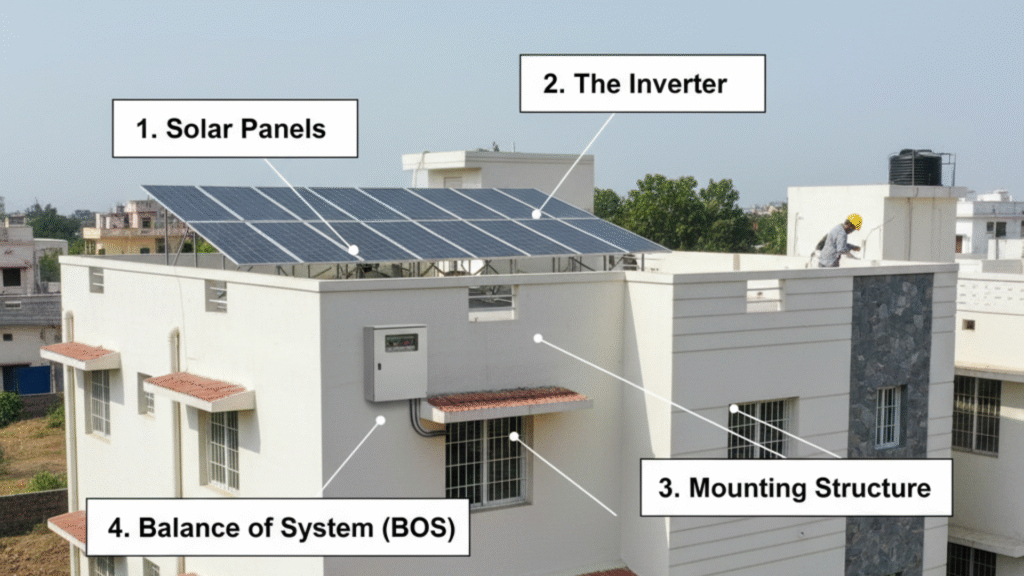
Clearly, the overall solar panel price for home covers more than just the physical panels. It represents a comprehensive package that includes all essential components and services required for a fully functional system. In essence, you are purchasing a ready-to-use power generation unit.
Major Components Influencing the Solar Panel Price for Home
- Solar Panels (Modules): This constitutes the largest single cost factor. The price varies significantly based on the type (Monocrystalline panels, for instance, offer higher efficiency and cost compared to Polycrystalline). Ultimately, high-quality, Tier-1 panels promise superior performance and a standard 25-year operational warranty.
- The Inverter: Often referred to as the brain of the system, the inverter converts the DC power from the panels into usable AC power for your home appliances. Thus, its type (String vs. Micro-inverters) and capacity directly impact the final installation cost.
- Mounting Structure and Racking: This structure securely fastens the panels to your roof. Therefore, the cost depends on the material (GI vs. Aluminium) and the complexity of your roof (flat vs. inclined). A robust, quality structure ensures decades of weather resistance.
- Balance of System (BOS): This category includes all necessary electrical components such as high-grade wiring, cables, junction boxes, earthing kits, and mandatory lightning/surge protectors. Crucially, never compromise on the quality of BOS for system safety and longevity.
Government Subsidy and Financing: Lowering the Net Solar Panel Price for Home
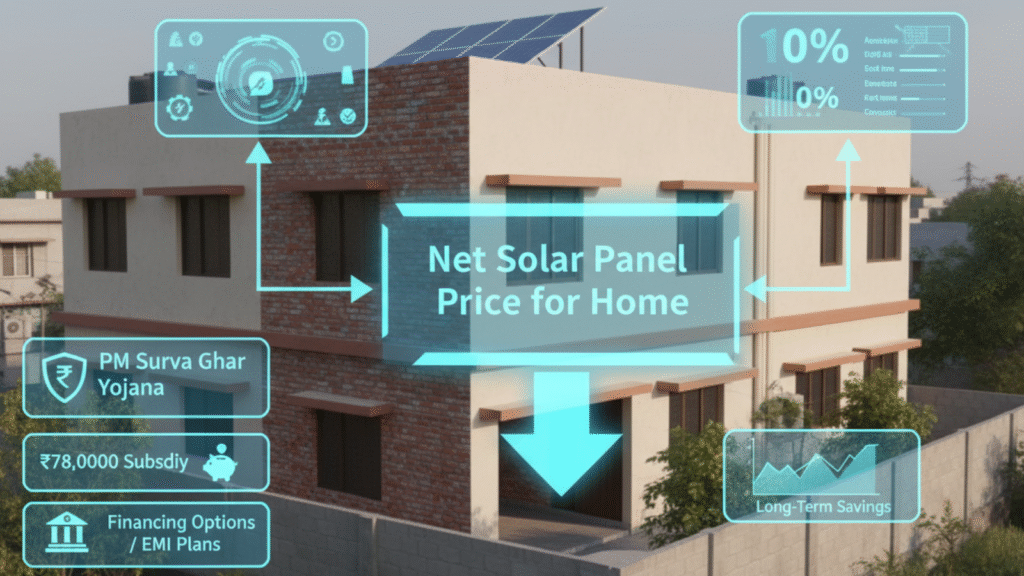
Understanding and utilizing the subsidy is paramount to significantly reducing your upfront solar panel price for home. The PM Surya Ghar Muft Bijli Yojana is the primary driver making residential solar accessible.
Utilizing the PM Surya Ghar Subsidy to Reduce Installation Price
The Central Financial Assistance (CFA) structure effectively cuts down the initial investment:
- For the First 2 kW: You receive ₹30,000 per kW (A maximum of ₹60,000 for a 2 kW system).
- For 3 kW & Above: The subsidy is capped at a fixed maximum of ₹78,000.
Furthermore, the disbursement process is streamlined: the approved subsidy amount is transferred directly to the homeowner’s bank account via Direct Benefit Transfer (DBT) after the system’s successful installation and inspection by the electricity board (DISCOM). Consequently, this reduces the effective net cost almost immediately.
Solar Financing Options
If the net solar panel price for home remains a challenge, financing options are widely available. For instance, most public and private sector banks offer dedicated solar loans (EMI plans) at competitive interest rates. Ultimately, financing allows you to start saving on electricity bills immediately while paying for the system over several years.
The 5-Step Process: Your Solar Panel Installation Breakdown and Timeline
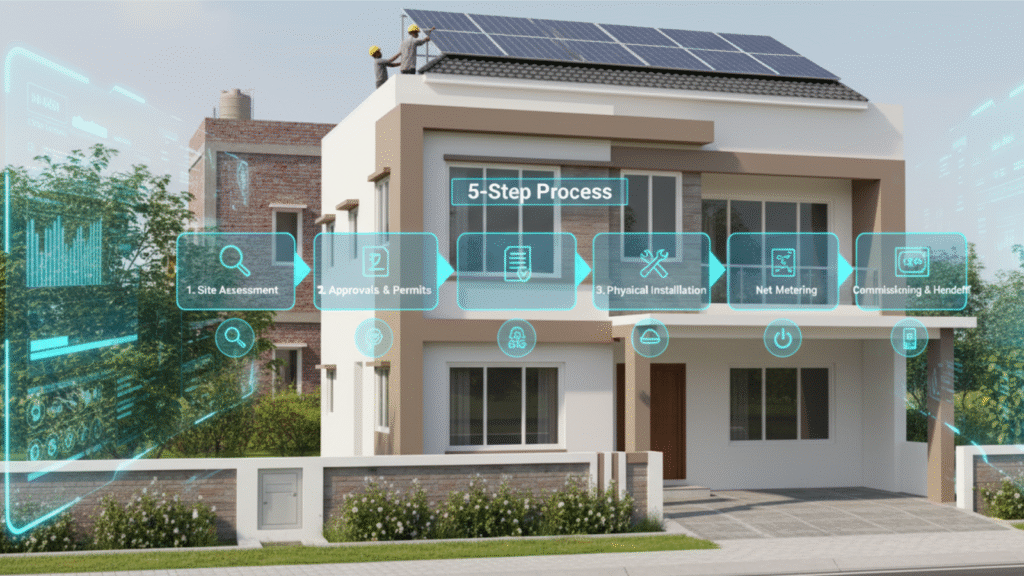
Once you approve the quotation, the journey to zero bills follows a professional and efficient five-step process. Thus, you can expect a smooth transition to clean energy.
- Site Assessment and Design: Initially, our experienced engineers conduct a detailed survey to measure the roof, analyze shading, and determine the optimal system size that aligns with your energy usage.
- Permit and Approval Management: Next, we manage all the bureaucratic steps, including submitting the Technical Feasibility Report to the DISCOM and applying for the CFA subsidy on the national portal.
- Physical Installation: The mounting structure is safely erected, followed by the careful placement and precise electrical wiring of the solar panels and the inverter. Importantly, all work strictly adheres to safety standards.
- Net Metering Installation: Following the setup, the utility provider replaces your existing meter with a bi-directional (Net) meter. This allows tracking both the electricity you consume and the surplus energy you export to the grid.
- Commissioning and Handoff: Finally, the system is switched on, thoroughly tested, and undergoes a final inspection by the DISCOM. You receive a complete guide on monitoring. The system is now live!
Factors Affecting the Final Solar Panel Price for Home Quote
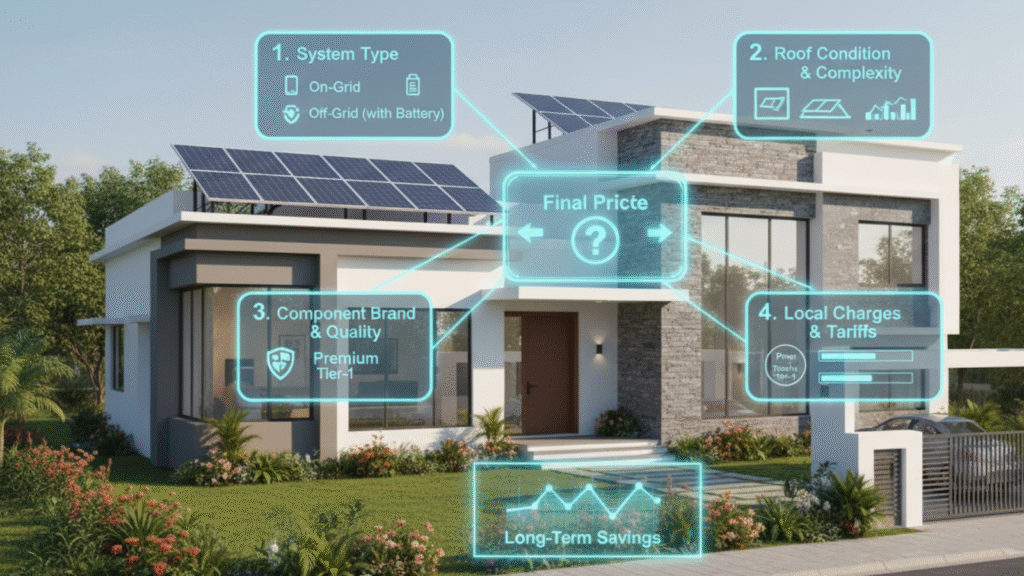
While the estimated costs serve as a guide, several specific factors can cause your final quote for the solar panel price for home to fluctuate:
- System Type (On-Grid vs. Off-Grid): An Off-Grid system requires expensive battery backups (like Lithium-Ion), significantly increasing the total project cost compared to a standard On-Grid system.
- Roof Type and Access: Complex or aged roof structures (e.g., steep slopes, multiple levels) demand specialized mounting equipment and additional labour, which slightly increases the installation price.
- Component Brands and Quality: Choosing high-efficiency, Tier-1 panels and premium inverters results in a better system but commands a slightly higher initial investment.
- Local Charges: State-specific taxes, local labor rates, and certain DISCOM service charges can vary by region.
Frequently Asked Questions (FAQ) about Solar Panel Price for Home
Q1. What is the typical Return on Investment (ROI) for the Cost of Solar Panel Installation for Home?
A. Solar panels typically come with a 25-year performance warranty. Therefore, the Payback Period (the time until your savings equal the net system cost) is generally 4 to 6 years in India, after which the remaining 20+ years deliver pure, free electricity savings.
Q2. Does the Solar Panel Price for Home generally include the battery?
A. No. The standard solar panel price for home cited in most quotes is for an On-Grid (Grid-Tied) system, which connects to the utility grid and does not require batteries. Conversely, a system including batteries is called an Off-Grid system and will increase the total cost significantly.
Q3. How much shadow-free roof space do I need for my solar panel installation?
A. As a rule of thumb, you need approximately 100 sq. ft. of shadow-free area for every 1 kW of solar capacity you install. Thus, a 3 kW system requires around 300 sq. ft.
Q4. How do I apply for the subsidy to lower the installation price?
A. You must register and apply on the official PM Surya Ghar national portal. Crucially, you must also select an installer registered with the DISCOM in your area to qualify for the CFA.
Conclusion: The Investment in Solar Panel Price for Home Pays for Itself
The initial solar panel price for home is clearly not an expense, but a high-yield investment. With substantial government subsidies (up to ₹78,000) and the ever-increasing cost of conventional electricity, rooftop solar has rapidly moved from a luxury to a necessity. By leveraging the PM Surya Ghar scheme, you ensure a quick payback period of 4 to 6 years.
Ultimately, you are not simply installing panels; you are securing your home against rising energy costs for the next two and a half decades.

